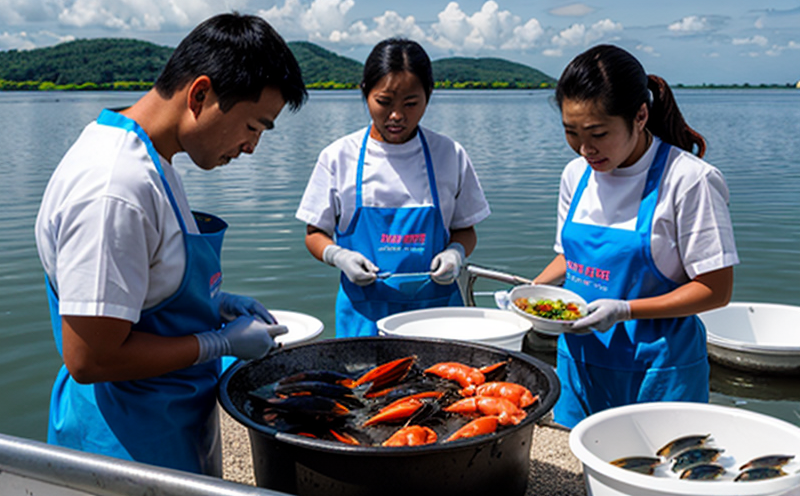ISO 9233 Marine Biotoxin Screening in Shellfish
The ISO 9233 standard is a critical tool used by laboratories around the globe to ensure public health and safety when it comes to marine biotoxins. This standard provides methods for screening shellfish for saxitoxin, which can lead to paralytic shellfish poisoning (PSP) if consumed in contaminated seafood products.
Saxitoxin is a potent neurotoxin produced by certain species of dinoflagellates and cyanobacteria that live in marine environments. When these toxins accumulate in shellfish like mussels, clams, oysters, and other filter-feeding organisms, they become dangerous for human consumption. The ISO 9233 method uses liquid chromatography with fluorescence detection (LC-FLD) to identify and quantify saxitoxin in shellfish samples.
The testing process begins with the collection of fresh shellfish samples from approved sources. These samples are then transported to our laboratory where they undergo rigorous quality control checks before processing. Once processed, the samples are extracted using a solvent-based method designed to separate target compounds from non-target substances effectively. After extraction, the sample is analyzed via LC-FLD.
The analytical procedure involves multiple steps including sample preparation, calibration curve generation, and data analysis. Our experts carefully analyze each step to ensure accuracy and precision in our results. It's important for us to maintain strict adherence to ISO 9233 guidelines throughout this process to guarantee reliable outcomes.
Our laboratory uses state-of-the-art equipment such as Agilent LC-FLD systems, which provide high sensitivity and selectivity necessary for detecting trace levels of saxitoxin. This ensures that even minute quantities are not missed during analysis. We also employ experienced analysts who have extensive experience working with this standard.
After completing the analysis, we issue a comprehensive report detailing our findings along with recommended action steps if any level above acceptable limits is detected. Compliance officers responsible for food safety should keep these results in mind when making decisions about product release or recall actions.
The importance of ISO 9233 cannot be overstated given its role in protecting public health and maintaining consumer confidence in seafood products worldwide. By adhering strictly to this standard, we contribute significantly towards ensuring that only safe and wholesome shellfish reach marketplaces across different countries.
International Acceptance and Recognition
The ISO 9233 standard is widely accepted by governments, regulatory bodies, and industries across multiple countries including the United States, Canada, Europe, Japan, Australia, New Zealand, China, and many others.
Many international organizations such as the World Health Organization (WHO), Food and Agriculture Organization of the United Nations (FAO), Codex Alimentarius Commission, and others recommend or require adherence to ISO 9233 for ensuring food safety related to marine biotoxins.
A number of countries have incorporated parts of this standard into their national legislation governing seafood quality control. For instance, the U.S. Food and Drug Administration (FDA) uses ISO 9233 as a reference when inspecting imported shellfish products.
Environmental and Sustainability Contributions
The implementation of rigorous testing protocols like those outlined in ISO 9233 plays an essential role in preserving marine ecosystems. By preventing the sale or consumption of contaminated shellfish, we help protect both wildlife populations dependent on these waters as well as human health.
Moreover, consistent monitoring helps maintain public trust and confidence in seafood products, encouraging sustainable fishing practices that preserve natural habitats for future generations.
Use Cases and Application Examples
This service finds application in various sectors including commercial fisheries, aquaculture farms, restaurants, food processing plants, and government agencies involved in regulatory affairs. Here are some specific scenarios where this testing might be utilized:
Before releasing harvested shellfish into the marketplace to ensure they meet safety standards.
During routine inspections conducted by health departments or other oversight bodies.
In response to outbreaks of PSP or other related illnesses linked to contaminated shellfish consumption.
Our clients appreciate the peace of mind that comes with knowing their products are free from harmful biotoxins. This enhances brand reputation while protecting against potential legal issues associated with product recalls due to contamination.





